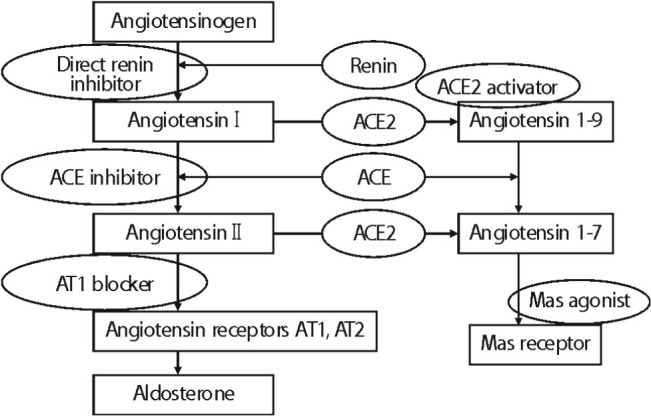Electrolyte Blood Press.
2013 Dec;11(2):41-45. 10.5049/EBP.2013.11.2.41.
Recent Update of Renin-angiotensin-aldosterone System in the Pathogenesis of Hypertension
- Affiliations
-
- 1Division of Nephrology, Department of Internal Medicine, KyungHee University, College of Medicine, Kyung Hee University Hospital at Gangdong, Seoul, Korea. jymoon@khu.ac.kr
- KMID: 2168399
- DOI: http://doi.org/10.5049/EBP.2013.11.2.41
Abstract
- The activation of renin-angiotensin-aldosterine system(RAAS) is one of the main pathogenesis of hypertension. All the components of RAAS are present in the kidneys at higher concentrations compared to plasma levels, and intrarenal formation of angiotensin II (Ang II) is independent of the systemic RAAS. There are some unique features in intrarenal RAAS compared to systemic RAAS. Unlike JG cells where Ang II inhibits renin release via the AngII type 1 (AT1) receptor by negative feedback, in the collecting duct Ang II stimulates renin expression via the AT1 receptor. Upregulated renin produced in the distal nephron may be able to support continued intrarenal Ang II formation leading to amplification or maintenance of the hypertensive state.The recently discovered angiotensin-converting enzyme-related carboxypeptidase 2 (ACE2)-Angiotensin-(1-7) Ang-(1-7)-Mas receptor axis has an opposing function to that of the ACE-Ang II-AT1 receptor axis.The ACE2 deficiency was associated with an increase in blood pressure, and ACE2 knockout mice have highlighted hypertensive response to Ang II infusion associated with exaggerated accumulation of Ang II in the kidney. Recently, several numbers of patients have been evaluated as the activators of ACE2-Ang-(1-7)-Mas receptor axis, which can be divided into two main classes: aimed to increase the activity of ACE2, and directed to stimulate the Ang-(1-7) receptor Mas. In order to investigate new targets for hypertension and kidney disease, further research on the function of the ACE-Ang-(1-7)-Mas receptor axis is required.
MeSH Terms
Figure
Reference
-
1. Price DA, Porter LE, Gordon M, et al. The paradox of the low-renin state in diabetic nephropathy. J Am Soc Nephrol. 1999; 10:2382–2391. PMID: 10541298.
Article2. Parving HH, Brenner BM, McMurray JJ, et al. Cardiorenal end points in a trial of aliskiren for type 2 diabetes. N Engl J Med. 2012; 367:2204–2213. PMID: 23121378.
Article3. Kobori H, Nangaku M, Navar LG, Nishiyama A. The intrarenalrenin-angiotensin system: from physiology to the pathobiology of hypertension and kidney disease. Pharmacol Rev. 2007; 59:251–287. PMID: 17878513.4. Navar LG, Prieto MC, Satou R, Kobori H. Intrarenalangietensin II and its contribution to the genesis of chronic hypertension. Curr Opin Pharmacol. 2011; 11:180–186. PMID: 21339086.5. Matsusaka T, Niimura F, Shimizu A, et al. Liver angiotensinogen is the primary source of renal angiotension II. J Am Soc Nephrol. 2012; 23:1181–1189. PMID: 22518004.6. Prieto-Carrasquero MC, Kobori H, Ozawa Y, et al. AT1 receptor-mediated enhancement of collecting duct rennin in angiotensin II-dependent hypertensive rats. Am J Physiol Renal Physiol. 2005; 289:F632–F637. PMID: 15870381.7. Zhou A, Carrell RW, Murphy MP, et al. A redox switch in angiotensinogen modulates angiotensin release. Nature. 2010; 468:108–111. PMID: 20927107.
Article8. Donoghue M, Hsieh F, Baronas E, et al. A novel angiotensin-converting enzyme-related carboxypeptidase (ACE2) converts angiotensin I to angiotensin 1-9. Circ Res. 2000; 87:E1–E9. PMID: 10969042.
Article9. Tipnis SR, Hooper NM, Hyde R, et al. A human homolog of angiotensin-converting enzyme. Cloning and functional expression as a captopril-insensitive carboxypeptidase. J Biol Chem. 2000; 275:33238–33243. PMID: 10924499.10. Vickers C, Hales P, Kaushik V, et al. Hydrolysis of biological peptides by human angiotensin-converting enzyme-related carboxypeptidase. J Biol Chem. 2002; 277:14838–14843. PMID: 11815627.
Article11. Crackower MA, Sarao R, Oudit GY, et al. Angiotensin-converting enzyme 2 is an essential regulator of heart function. Nature. 2002; 417:822–828. PMID: 12075344.
Article12. Tikellis C, Johnston CI, Forbes JM, et al. Characteriza tion of renal angiotensin-converting enzyme 2 in diabetic nephropathy. Hypertension. 2003; 41:392–397. PMID: 12623933.13. Gallagher PE, Chappell MC, Ferrario CM, Tallant EA. Distinct roles for ANG II and ANG-(1-7) in the regulation of angiotensin-converting enzyme 2 in rat astrocytes. Am J Physiol Cell Physiol. 2006; 290:C420–C426. PMID: 16176966.
Article14. Esteban V, Heringer-Walther S, Sterner-Kock A, et al. Angiotensin-(1-7) and the g protein-coupled receptor MAS are key players in renal inflammation. PLoS One. 2009; 4:e5406. PMID: 19404405.
Article15. Sayed-Tabatabaei FA, Oostra BA, Isaacs A, van Duijn CM, Witteman JC. ACE polymorphisms. Circ Res. 2006; 98:1123–1133. PMID: 16690893.16. Song SB, Jin HS, Hong KW, et al. Association between renin-angiotensin-aldosterone system-related genes and blood pressure in a Korean population. Blood Press. 2011; 20:204–210. PMID: 21342026.
Article17. Burrell LM, Harrap SB, Velkoska E, Patel SK. The ACE2 gene: Its potential as a functional candidate for cardiovascular disease. Clin Sci. 2013; 124:65–76. PMID: 23013041.
Article18. Rentzsch B, Todiras M, Iliescu R, et al. Transgenic angiotensin-converting enzyme 2 overexpression in vessels of SHRSP rats reduces blood pressure and improves endothelial function. Hypertension. 2008; 52:967–973. PMID: 18809792.
Article19. Luque M, Martin P, Martell N, et al. Effects of captopril related to increased levels of prostacyclin and angiotensin-(1-7) in essential hypertension. J Hypertens. 1996; 14:799–805. PMID: 8793704.
Article20. Hernández Prada JA, Ferreira AJ, Katovich MJ, et al. Structure-basedidentification of small-moleculeangiotensin-converting enzyme 2 activators as novel antihyperten-siveagents. Hypertension. 2008; 51:1312–1317. PMID: 18391097.21. Oudit GY, Liu GC, Zhong J, et al. Human recombinant ACE2 reduces the progression of diabetic nephropathy. Diabetes. 2010; 59:529–538. PMID: 19934006.
Article22. Wiemer G, Dobrucki LW, Louka FR, Malinski T, Heitsch H. AVE 0991, a nonpeptide mimic of the effect of angiotensin-(1-7) on the endothelium. Hypertension. 2002; 40:847–852. PMID: 12468568.23. Shemesh R, Toporik A, Levine Z, et al. Discovery and validation of novel peptideagonists for G-protein-coupled receptors. J Biol Chem. 2008; 283:34643–34649. PMID: 18854305.
- Full Text Links
- Actions
-
Cited
- CITED
-
- Close
- Share
- Similar articles
-
- New drugs for treatment of hypertension
- Renin Angiotensin System in Rabbit Corpus Cavernosum: Functional Characterization of Angiotensin II Receptors
- Use of Angiotensin Converting Enzyme Inhibitors and Angiotensin Receptor Blockers: A Closer Look at Hyperkalemia
- Hypertension Controlled by Adrenalectomy: A Case of Primary Aldosteronism
- A Case of Aldosteronoma


